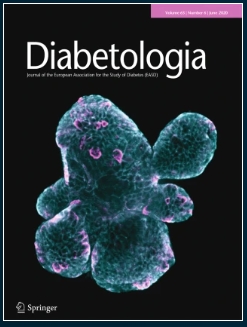慢性营养不良中胰岛素依赖型糖尿病的表型:β细胞应激和免疫功能障碍-撒哈拉以南农村5型糖尿病的观点
IF 10.2
1区 医学
Q1 ENDOCRINOLOGY & METABOLISM
引用次数: 0
摘要
在经济发达国家,大多数患有胰岛素依赖型糖尿病的瘦人患有自身免疫性1型糖尿病。然而,在低收入和中等收入国家(LMIC)的许多农村地区,40-50%具有类似临床表现的个体在最初临床表现时糖尿病相关自身抗体呈阴性。即使在有自身免疫过程证据的患者中,其表型也不同于1型糖尿病的经典表现:自身抗体谱改变;发病高峰年龄晚;并且,在青春期后的临床表现中,男性的优势更为明显。胰岛素依赖型糖尿病在LMIC患者中的发病率很低,即使在同时评估有和没有自身抗体的患者时也是如此。本文提出了一种可能的病理生理机制框架,解释了慢性营养不良和微量营养素缺乏如何改变胰岛素依赖型糖尿病的表现。撒哈拉以南非洲农村地区(SSA)的居民几乎完全依赖当地在营养缺乏的土壤中种植的主食。由此产生的慢性营养不良,通常是代际的,影响线性生长和身体形态,并对β细胞发育和功能产生直接的免疫和非免疫影响。营养不良直接影响胸腺功能,改变自身免疫特征,通常与社会剥夺和寄生虫感染有关,这两者都可以延迟和改变(自身)免疫反应。营养不良的非免疫效应包括β细胞应激,与细胞凋亡和新抗原的形成有关。营养不良和社会剥夺的环境影响会影响胰岛素依赖型糖尿病表型的改变,这可以通过在经济发达国家出生并发展为胰岛素依赖型糖尿病的SSA移民的后代向经典1型糖尿病表型的转变来证明。表型改变的程度取决于父母在收养国生活的时间长短。最近有人提出,那些营养不良/营养不良的胰岛素依赖型糖尿病被称为5型糖尿病。临床医生需要认识到农村低收入国家慢性营养不良导致的胰岛素依赖型糖尿病的表型改变。此外,需要改变农业实践,以改善农村人口所消费食物的营养成分。本文章由计算机程序翻译,如有差异,请以英文原文为准。
Phenotype of insulin-dependent diabetes in chronic undernutrition: beta cell stress and immune dysfunction-a rural sub-Saharan perspective on type 5 diabetes.
In economically developed countries most lean individuals presenting with insulin-dependent diabetes have autoimmune type 1 diabetes. However, in many rural areas of low- and middle-income countries (LMIC), 40-50% of individuals with a similar clinical presentation are negative for diabetes-associated autoantibodies at initial clinical presentation. The phenotype differs from the classical presentation of type 1 diabetes even in those with evidence of an autoimmune process: altered autoantibody profile; later peak age of onset; and, in those with post-pubertal clinical presentation, more marked male predominance. The incidence of insulin-dependent diabetes in LMIC is low, even when assessing those with and without autoantibodies together. A framework of possible pathophysiological mechanisms underlying the observed phenotypic differences is presented to explain how chronic undernutrition and micronutrient deficiencies might alter the presentation of insulin-dependent diabetes. Inhabitants of rural sub-Saharan Africa (SSA) depend almost entirely on staple foods grown locally in nutrient-deficient soil. The resulting chronic undernutrition, often intergenerational, affects linear growth and body morphology, and has direct immune and non-immune effects on beta cell development and function. Undernutrition directly affects thymic function, alters the autoimmune profile and is often associated with social deprivation and parasitic infection, both of which can delay and modify the (auto)immune response. Non-immune effects of undernutrition include beta cell stress, associated with apoptosis and formation of neoantigens. That environmental effects of undernutrition and social deprivation affect the altered insulin-dependent diabetes phenotype is shown by the movement back towards a classical type 1 diabetes phenotype in offspring of emigrants from SSA who are born in and develop insulin-dependent diabetes in an economically developed country. The degree of phenotype change depends on how long the parents have lived in their adopted country. It has recently been proposed that insulin-dependent diabetes in those who are mal/undernourished be called type 5 diabetes. There is need for clinician recognition of the altered phenotype(s) of insulin-dependent diabetes resulting from chronic undernutrition in rural LMIC. Additionally, changes in agricultural practice are needed to improve the nutrient content of food consumed by the rural population.
求助全文
通过发布文献求助,成功后即可免费获取论文全文。
去求助
来源期刊

Diabetologia
医学-内分泌学与代谢
CiteScore
18.10
自引率
2.40%
发文量
193
审稿时长
1 months
期刊介绍:
Diabetologia, the authoritative journal dedicated to diabetes research, holds high visibility through society membership, libraries, and social media. As the official journal of the European Association for the Study of Diabetes, it is ranked in the top quartile of the 2019 JCR Impact Factors in the Endocrinology & Metabolism category. The journal boasts dedicated and expert editorial teams committed to supporting authors throughout the peer review process.
 求助内容:
求助内容: 应助结果提醒方式:
应助结果提醒方式:


